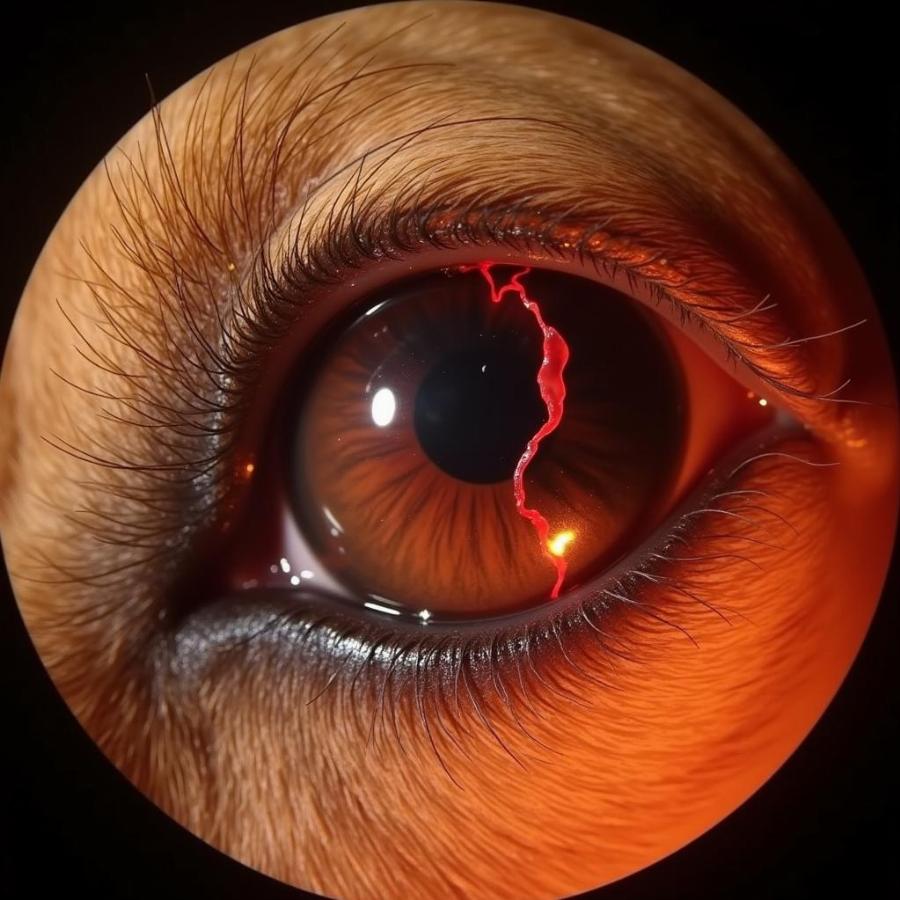Retinal detachment in dogs, a serious eye condition, can lead to blindness if left untreated. Surgical reattachment is often necessary, but like any medical procedure, it comes with potential dog retinal reattachment side effects. Understanding these potential complications is crucial for any owner considering this procedure for their beloved canine companion. This article will discuss the procedure, potential risks, and recovery process to help you make informed decisions regarding your dog’s eye health.
Understanding Dog Retinal Reattachment Surgery
Retinal detachment occurs when the retina, the light-sensitive tissue at the back of the eye, separates from its supporting layers. This can happen due to various reasons, including trauma, genetics, and certain diseases. When the retina detaches, it loses its blood supply and can’t function properly, leading to vision impairment or even blindness. Surgical reattachment aims to reposition the retina and restore its connection to the underlying tissue.
 Hình ảnh võng mạc bị bong ra ở mắt chó
Hình ảnh võng mạc bị bong ra ở mắt chó
Several surgical techniques are available, including laser surgery, cryotherapy (freezing), and scleral buckling (placing a band around the eye). The chosen method depends on the severity and cause of the detachment.
Potential Dog Retinal Reattachment Side Effects
While retinal reattachment surgery can be highly effective in restoring vision, it’s essential to be aware of the potential risks and side effects. These can vary depending on the surgical technique used and the individual dog.
- Inflammation: Post-operative inflammation is common and usually managed with medication. Signs of excessive inflammation include redness, swelling, and discharge.
- Infection: Though rare, infection is a serious complication. Strict post-operative care and hygiene are crucial to minimize this risk.
- Glaucoma: Increased pressure within the eye (glaucoma) can occur after surgery and requires careful monitoring and treatment.
- Cataract Formation: Cataracts, clouding of the eye’s lens, can sometimes develop after retinal surgery, especially in older dogs.
- Hemorrhage (Bleeding): Bleeding can occur during or after surgery, but it’s usually minor and resolves on its own.
- Failure of Reattachment: In some cases, the retina may not reattach successfully, requiring further surgery.
Post-Operative Care and Recovery
Proper post-operative care is vital for minimizing dog retinal reattachment side effects and ensuring a successful recovery. This typically involves:
- Medication: Anti-inflammatory drugs, antibiotics, and pain relievers are often prescribed.
- Eye Drops: Medicated eye drops help control inflammation and prevent infection.
- Activity Restriction: Limiting your dog’s activity is crucial to allow the retina to heal properly. This may involve using an Elizabethan collar (cone) to prevent scratching or rubbing the eye.
- Regular Check-ups: Frequent veterinary visits are necessary to monitor healing and address any complications.
What are the signs of complications after retinal reattachment surgery in dogs?
Excessive redness, swelling, discharge, squinting, or pain could indicate complications. Contact your veterinarian immediately if you observe these signs.
How long does it take for a dog’s retina to heal after reattachment surgery?
Healing time varies, but generally, it takes several weeks for the retina to heal fully. Strict adherence to post-operative care instructions is crucial during this period.
Is retinal reattachment surgery always successful in dogs?
While the success rate is generally good, it’s not always guaranteed. Factors like the severity of the detachment, the underlying cause, and the dog’s overall health can influence the outcome.
Can a dog see normally after retinal reattachment surgery?
The extent of vision recovery depends on the degree of damage before surgery and the success of the reattachment. Some dogs regain near-normal vision, while others may experience some permanent vision impairment.
Conclusion
Dog retinal reattachment side effects can be concerning, but with proper care and monitoring, most complications can be managed effectively. Understanding the potential risks and benefits is essential for making informed decisions about your dog’s eye health. If you suspect your dog has a detached retina, consult your veterinarian immediately. Early diagnosis and treatment are crucial for preserving vision and ensuring the best possible outcome.
FAQ
- What are the common signs of retinal detachment in dogs? Signs include sudden vision loss, cloudiness in the eye, dilated pupils, and changes in eye appearance.
- How much does dog retinal reattachment surgery cost? The cost varies depending on the surgical technique, the veterinarian, and geographic location.
- Is there a way to prevent retinal detachment in dogs? While not all cases are preventable, regular veterinary check-ups can help identify and address potential risk factors early on.
- What breeds are prone to retinal detachment? Some breeds, such as Collies, Shetland Sheepdogs, and Miniature Schnauzers, have a higher predisposition to retinal detachment.
- Can a detached retina heal on its own in dogs? No, a detached retina will not heal spontaneously and requires surgical intervention to restore vision.
Looking for more information on dog eye health?
Check out our other helpful articles: [Link to relevant article on Beaut Dogs if available]
Beaut Dogs: Your Trusted Source for Canine Care
Beaut Dogs is your one-stop resource for all things canine, offering expert advice and comprehensive information on dog breeds, health, training, and more. We are dedicated to providing you with the knowledge and resources you need to give your furry friend the best possible care. For personalized guidance and support, contact us at Email: [email protected]. Beaut Dogs is committed to helping you navigate the wonderful world of dog ownership.